MEG current phantom (Elekta-Neuromag)
Authors: Ken Taylor, Francois Tadel, John Mosher
This tutorial explains how to import and process Elekta-Neuromag current phantom recordings. We decided to release this example for testing and cross-validation purposes. With these datasets, we can evaluate the equivalence of various forward models and dipole fitting methods in the case of simple recordings with single dipoles. The recordings are available in two file formats (native and FIF) to cross-validate the file readers available in Brainstorm and MNE. A similar page exists for the CTF phantom.
Contents
License
This tutorial dataset remains a property of its authors: Ken Taylor, John Mosher (Epilepsy Center, Cleveland Clinic Neurological Institute, Cleveland, OH USA).
If you reference this dataset in your publications, please acknowledge them and cite Brainstorm as indicated on the website. For questions, please contact us through the forum.
The phantom
A current phantom is provided with the Elekta Neuromag for checking the system performance. It contains 32 artificial dipoles and four fixed head-position indicator coils. The phantom is based on the mathematical fact that an equilateral triangular line current produces equivalent magnetic field distribution to that of a tangential current dipole in a spherical conductor, provided that the vertex of the triangle and the origin of the conducting sphere coincide. For a detailed description of how the phantom works, see here.
The phantom dipoles are energized using an internal signal generator which also feeds the HPI coils. An external multiplexer box is used to connect the signal to the individual dipoles. Only one dipole can be activated at a time. The location of the dipole is recorded relative to the center of the sphere (0,0,0)m, where X is positive toward the nasion, Y is positive toward the left ear and Z is positive toward the top of the head (see the CoordinateSystems tutorial for more details).
Use of the phantom is shown below. Note that the uncovered version is the phantom that came with the Neuromag-122, which explicitly shows the wiring. The covered version uses the same principle but somewhat different dipole locations. Further details are available in Section 7.2 of the User's Manual.
References
- R.J. Ilmoniemi, M.S. Hämäläinen, and J. Knuutila, The Forward and Inverse Problems in the Spherical Model. In: Biomagnetism: Applications and Theory, eds. H. Weinberg, G. Stroink, T. Katil, Pergamon Press, 1985.
- Elekta Neuromag System Hardware User's Manual, Revision G, September 2005.
Description of the experiment
Files distributed as part of the phantom Elekta tutorial:
kojak_all_2000nAm_pp_no_chpi_no_ms_raw.fif
Source = 2000 nAm. This corresponds to an unrealistically strong 1,000 nA-m (2,000 nA-m peak to peak) dipole that gives the highest SNR visualization of the experimental source.kojak_all_200nAm_pp_no_chpi_no_ms_raw.fif
Source = 200 nAm. This is a weaker dipole, closer to the range of amplitudes we can expect from inter-ictal spikes due to epilepsy, visible in raw data.kojak_all_20nAm_pp_no_chpi_no_ms_raw.fif
Source = 20 nAm. This represents some of the weakest sources we expect in evoked studies which require averaging to detect and estimate (i.e. generally cannot be seen in single trials).- All recordings were performed by John Mosher in the MEG lab at the Cleveland Clinic with an Elekta phantom.
Download and installation
Requirements: You have followed the introduction tutorials and Brainstorm is installed.
Go to the Download page and download the file: sample_phantom_elekta.zip
- Unzip it in a folder that is not in any of the Brainstorm folders (program folder or database folder)
- Start Brainstorm (Matlab scripts or stand-alone version)
Select the menu File > Create new protocol. Name it TutorialPhantomElekta and select:
No, use individual anatomy,
No, use one channel file per acquisition run (MEG).
Generate anatomy
In the Matlab command window: type "generate_phantom_elekta".
This creates a new subject Kojak (so named after the 70's TV show) and generates the "anatomy" for this device: one volume and a few surfaces representing the geometry of the phantom.
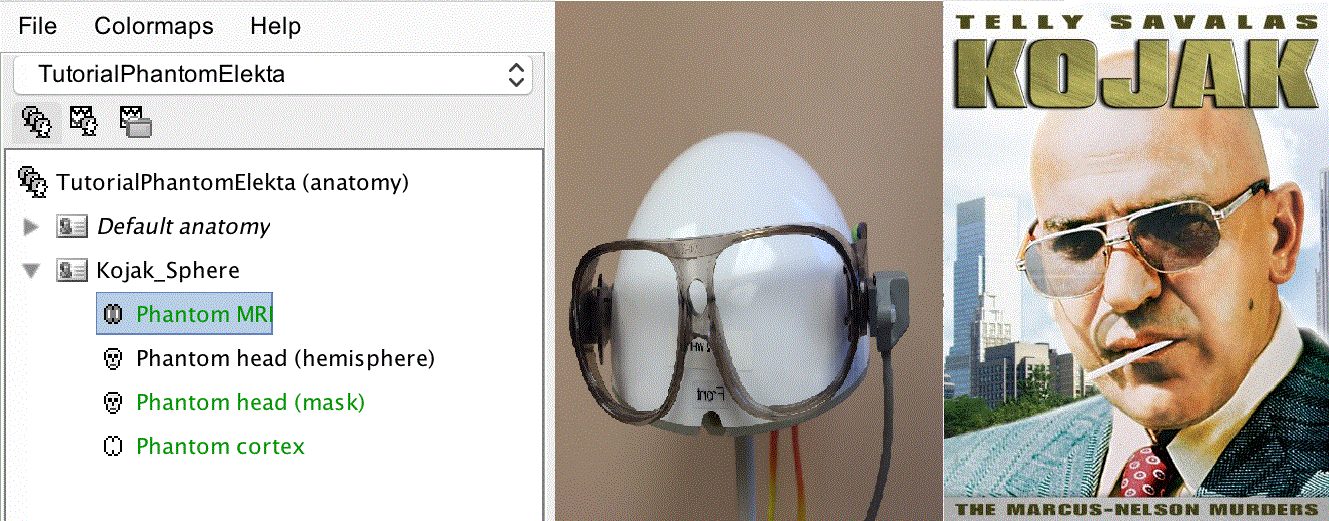
You can display the MRI and surfaces as presented in the introduction tutorials.
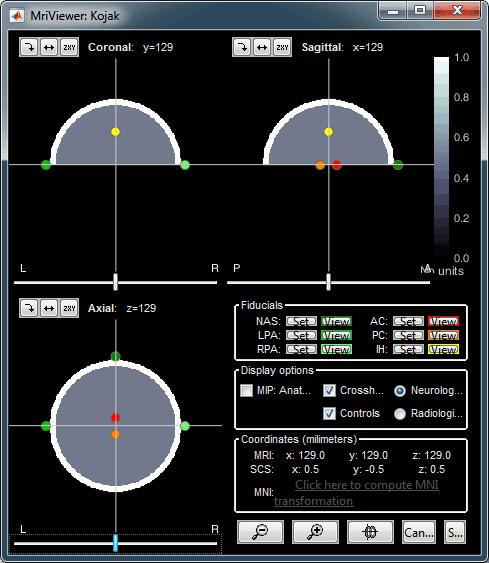
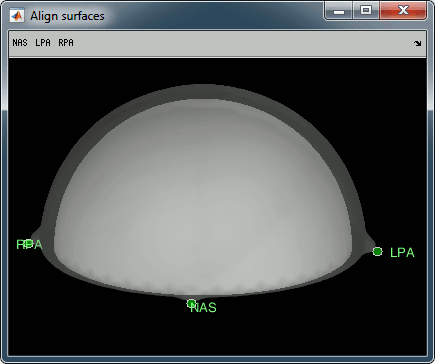
Access the recordings
We can now review one of the raw kojak data sets. These have been generated by sequentially activating each of the 32 phantom dipoles in a single raw file.
Switch to the functional data view by clicking the second button under the protocol name.
Right-click on the subject folder > Review raw file.
Select the file format: "MEG/EEG: Elekta-Neuromag (*.fif)"
Select the 200nA file: sample_phantom_elekta/kojak_all_200nAm...fif
Click Event channel, select STI201, and hit OK.
A figure is opened at the end of the import to show the position of the phantom in the MEG:

Organize the events
- Double click the link to raw file: it opens the recordings and shows the list of the events.
- In the Record tab, rename your groups so that the ordering remains convenient:
Double-click on event group "1" (or menu Events > Rename group), rename it to 01.
- Repeat this for events #2-#9.
- Some unnecessary triggers are generated by the neuromag system, we will delete them:
Select all the categories with only one event (#256-#7939), press the delete key.
- These steps can also be performed from your MATLAB command window:
- Close the file viewer.
Right-click on the link > File > Export to Matlab > "link"
- Run the lines of code below:
for i = 1:32 STR = str2num(link.F.events(i).label); link.F.events(i).label = sprintf('%02.0f',STR); end link.F.events(33:end) = []; Right-click on the link > File > Import from Matlab > "link".
- There is also a switching transient in the phantom generator which should be removed:
Select category 01, click on the first time instant and press the delete key.
Events should now appear as per the image below on the right:
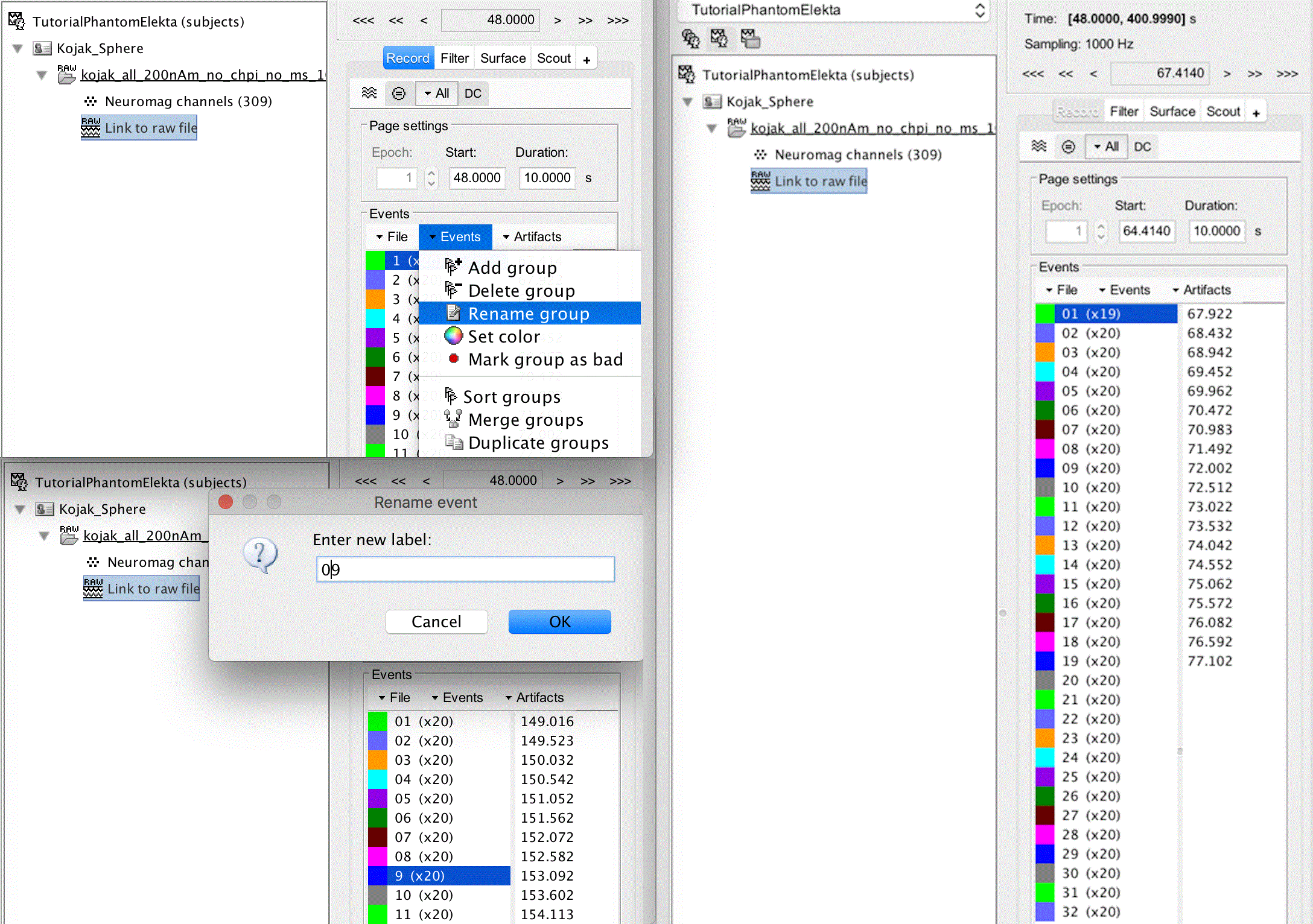
- Close the recordings figure to save the modifications.
Import the dipole events
Right click on Link to raw file > Import in database:
Select all the events #01-#32, Epoch time = [-100,300]ms
Uncheck Apply SSP/ICA projectors (we will use noise covariance to stabilize the data)
Check Remove DC offset, time range = [-100,-10]ms
Resample the recordings to 100Hz (change from 1000Hz)
Do not create separate folders
Click Import
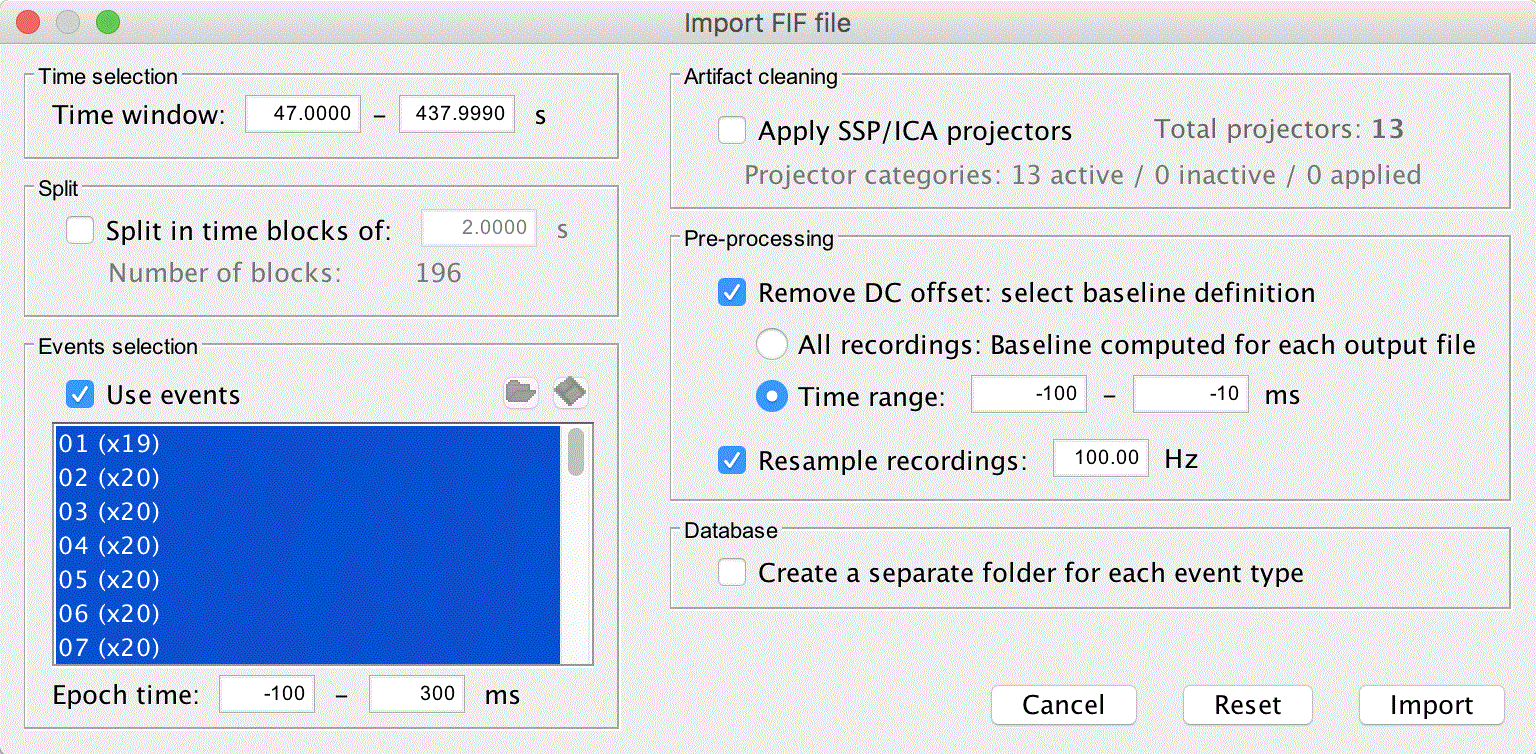
Noise covariance
With the epochs imported, we can now calculate the noise covariance from the prestims:
- Select all the imported epochs (click on the first group, hold the shift key, click on the last).
Right-click on any epochs group > Noise covariance > Compute from recordings.
Keep the default options, and hit OK.
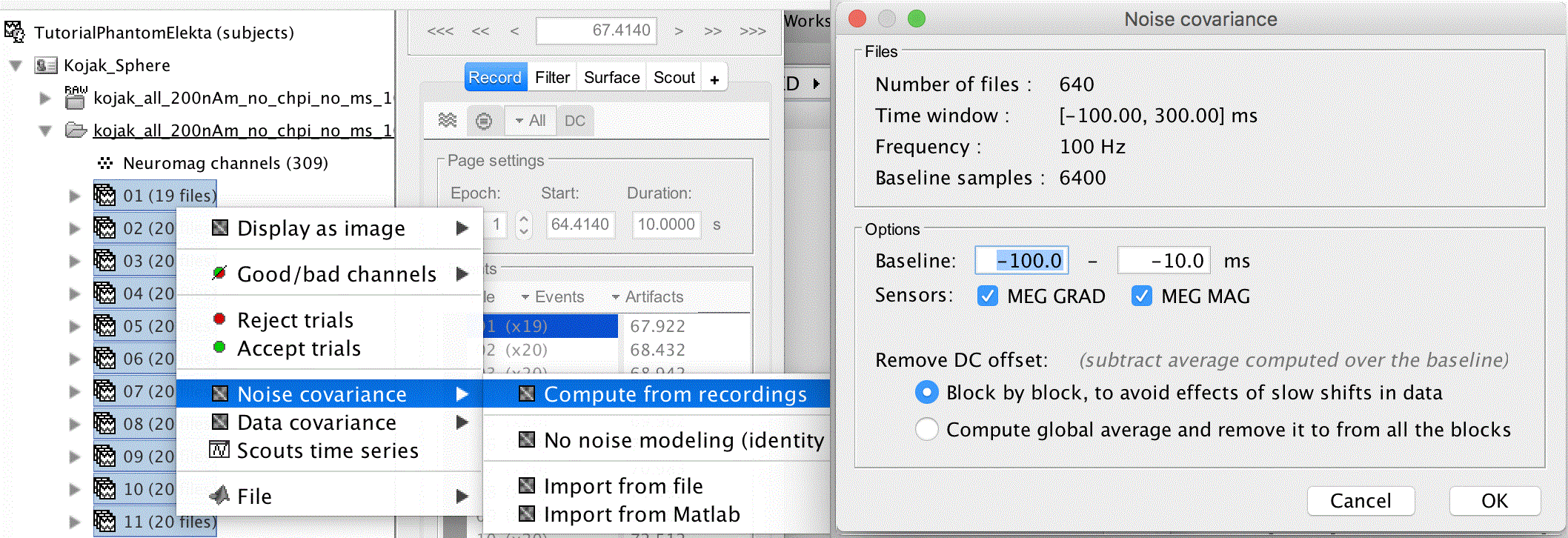
Average trials
- In Process1, select all the 32 trials groups.
Run process Average > Average files > By trial group (folder average).

Head modeling
Right-click on the channel file > Compute head model > MRI volume, Single sphere.

- A figure opens showing a sphere fit to the phantom, however we can see that the location is not exactly (0,0,0). We can adjust it manually:
Click the Edit sphere properties button in the top toolbar.
Change the center location to [ 0 0 0 ] and hit OK.
Click the [OK] button. A window appears allowing adjustment of the volume source grid.
Select Regular grid (isotropic) with Grid resolution 2.5mm.
This results in an around 56K grid point, which is sufficient.
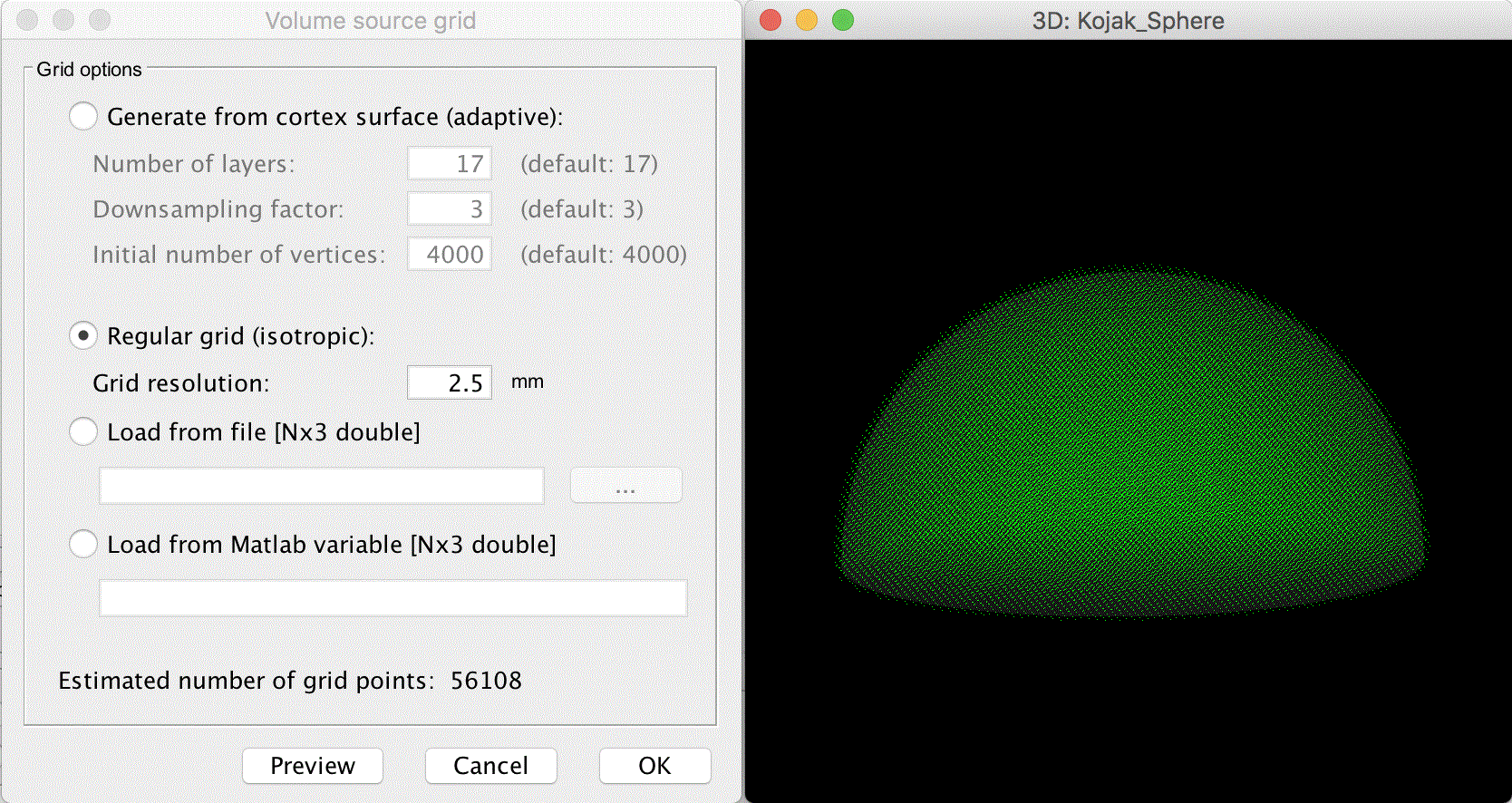
Dipole source estimation
Right click the Single sphere (volume) and select Compute sources [2016]
Select: Dipole modeling, Unconstrained, MEG GRAD only
Click Show details to show the advanced options, select No covariance regularization
Ignore the other settings, and click OK.
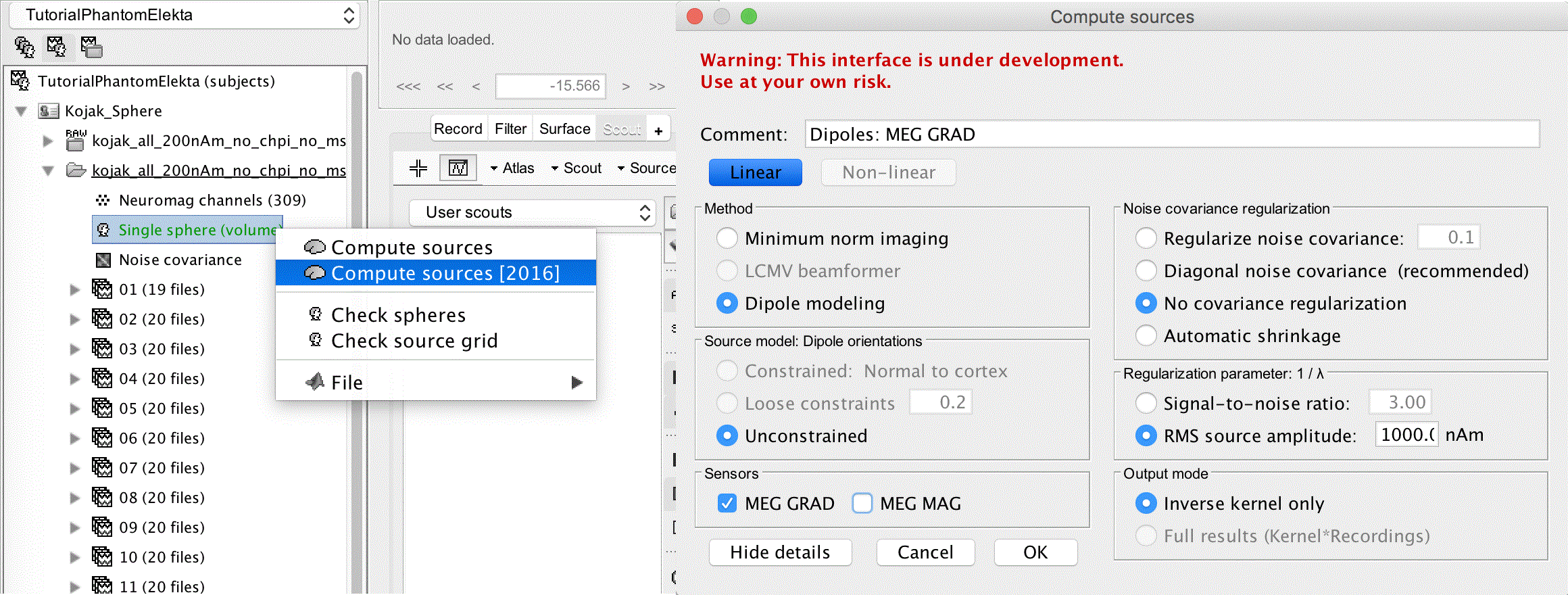
Dipole scanning
In Process1, select the 32 averages and click on [Process sources].
Run process: Sources > Dipole scanning > Time window=[60,60]ms
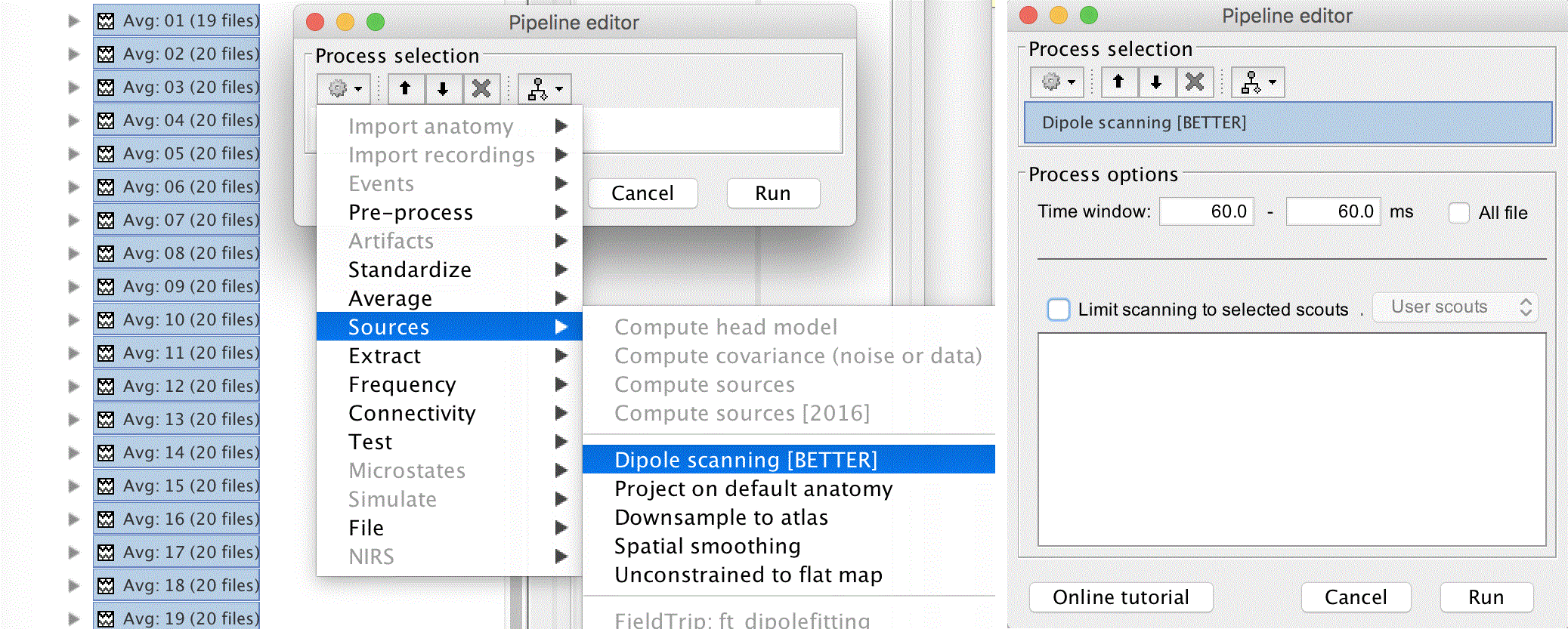
- We would like to group the 32 new dipole files together. Two methods for this:
Select all the dipoles files from the database explorer (requires that you expand all the average nodes), right-click > Merge dipoles.
- Execute the lines of code below in your Matlab command window:
sStudy = bst_get('StudyWithCondition','Kojak/kojak_all_200nAm_pp_no_chpi_no_ms_raw'); DipolesFile = dipoles_merge({sStudy.Dipoles.FileName});
- As an optional step, we can sign flip the dipoles so that they all point up for convenience:
Right-click on dipole file Merge: 32 files > File > Export to Matlab > "dip"
- Execute the lines of code below in your Matlab command window:
for i = 1:32 dip.Dipole(i).Amplitude = dip.Dipole(i).Amplitude * ... sign(dip.Dipole(i).Amplitude(3)); end dip.Comment = [dip.Comment ' | flipped']; Right-click on the folder containing all these files > File > Import from Matlab > "dip".
- Merged the flipped dipoles file with the true dipole positions:
Select "Merge: 32 files | flipped" and "True phantom dipoles" (in folder TrueDipoles)
Right-click on one of them > Merge dipoles.
- Rename this file into something more meaningful (eg. "comparison").
Right-click on this last file > Display on MRI (3D), or double-click on the file. The true dipole locations are shown in blue (0ms) along with the estimated locations in red (60ms).
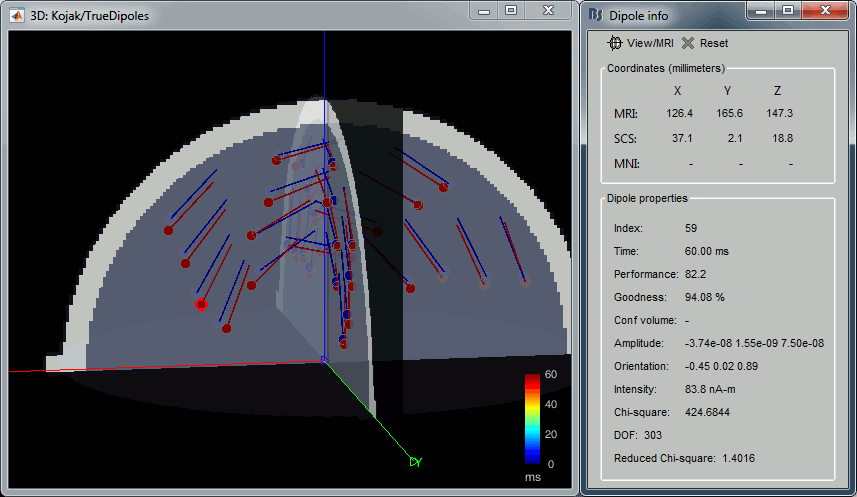
Results
Dipole stats Dipole Loc (mm) Amp (nA-m) Gof Perf Chi2 RChi2 -------------------------------------------------------------------------- 01 - [ -0.4 -60.4 21.3] 75.3 98.8% 208.6 532 (201) 2.65 02 - [ 2.1 -47.9 23.8] 80.2 97.9% 117.4 303 (201) 1.51 03 - [ -0.4 -35.4 23.8] 80.1 94.2% 64.5 258 (201) 1.28 04 - [ -0.4 -25.4 21.3] 75.0 84.3% 36.3 245 (201) 1.22 05 - [ 2.1 -35.4 51.3] 83.8 98.2% 154.4 442 (201) 2.20 06 - [ 2.1 -25.4 43.8] 90.8 96.8% 87.9 258 (201) 1.28 07 - [ 2.1 -12.9 38.8] 94.9 91.9% 53.2 249 (201) 1.24 08 - [ 2.1 -5.4 33.8] 75.7 80.9% 30.6 222 (201) 1.11 09 - [-60.4 -0.4 21.3] 77.2 98.7% 204.2 560 (201) 2.78 10 - [-47.9 -0.4 23.8] 82.3 98.1% 120.0 282 (201) 1.40 11 - [-35.4 -0.4 23.8] 83.2 94.7% 69.0 268 (201) 1.33 12 - [-25.4 -0.4 21.3] 79.9 88.7% 42.3 227 (201) 1.13 13 - [-35.4 2.1 51.3] 83.8 98.4% 178.3 513 (201) 2.55 14 - [-27.9 2.1 46.3] 76.8 96.8% 101.6 336 (201) 1.67 15 - [-15.4 2.1 38.8] 87.6 93.4% 60.9 261 (201) 1.30 16 - [ -5.4 2.1 33.8] 73.0 82.9% 35.1 255 (201) 1.27 17 - [ -0.4 47.1 41.3] 84.9 98.6% 176.4 434 (201) 2.16 18 - [ -0.4 44.6 31.3] 75.9 98.0% 106.0 229 (201) 1.14 19 - [ -0.4 39.6 18.8] 79.5 94.4% 68.6 277 (201) 1.38 20 - [ -0.4 34.6 8.8] 72.1 88.8% 42.3 224 (201) 1.12 21 - [ -0.4 14.6 61.3] 78.8 98.3% 131.7 305 (201) 1.52 22 - [ 2.1 17.1 48.8] 86.7 96.1% 82.2 272 (201) 1.36 23 - [ 2.1 22.1 36.3] 84.2 92.6% 55.9 251 (201) 1.25 24 - [ 2.1 19.6 23.8] 87.5 83.9% 36.7 259 (201) 1.29 25 - [ 47.1 2.1 43.8] 80.5 97.1% 94.2 267 (201) 1.33 26 - [ 42.1 -0.4 31.3] 82.8 93.7% 61.7 255 (201) 1.27 27 - [ 37.1 -0.4 18.8] 86.2 88.7% 45.6 265 (201) 1.32 28 - [ 29.6 2.1 13.8] 81.2 87.3% 32.6 155 (201) 0.77 29 - [ 14.6 2.1 58.8] 91.3 97.6% 129.0 406 (201) 2.02 30 - [ 17.1 2.1 48.8] 85.6 95.8% 76.7 258 (201) 1.28 31 - [ 19.6 2.1 38.8] 78.5 91.1% 48.3 227 (201) 1.13 32 - [ 19.6 -0.4 23.8] 90.2 84.2% 34.2 220 (201) 1.09 Location errors from true Dipole Loc (mm) True (mm) Diff [x y z] Norm (mm) ------------------------------------------------------------------------------ 01 - [ -0.4 -60.4 21.3] [ 0.0 -59.7 22.9] [ -0.4 -0.7 -1.6] ( 1.8) 02 - [ 2.1 -47.9 23.8] [ 0.0 -48.6 23.5] [ 2.1 0.7 0.3] ( 2.3) 03 - [ -0.4 -35.4 23.8] [ 0.0 -35.8 25.5] [ -0.4 0.4 -1.7] ( 1.8) 04 - [ -0.4 -25.4 21.3] [ 0.0 -24.8 23.1] [ -0.4 -0.6 -1.8] ( 2.0) 05 - [ 2.1 -35.4 51.3] [ 0.0 -37.2 52.0] [ 2.1 1.8 -0.7] ( 2.9) 06 - [ 2.1 -25.4 43.8] [ 0.0 -27.5 46.4] [ 2.1 2.1 -2.6] ( 4.0) 07 - [ 2.1 -12.9 38.8] [ 0.0 -15.8 41.0] [ 2.1 2.9 -2.2] ( 4.2) 08 - [ 2.1 -5.4 33.8] [ 0.0 -7.9 33.0] [ 2.1 2.5 0.8] ( 3.4) 09 - [-60.4 -0.4 21.3] [-59.7 -0.0 22.9] [ -0.7 -0.4 -1.6] ( 1.8) 10 - [-47.9 -0.4 23.8] [-48.6 -0.0 23.5] [ 0.7 -0.4 0.3] ( 0.9) 11 - [-35.4 -0.4 23.8] [-35.8 -0.0 25.5] [ 0.4 -0.4 -1.7] ( 1.8) 12 - [-25.4 -0.4 21.3] [-24.8 -0.0 23.1] [ -0.6 -0.4 -1.8] ( 2.0) 13 - [-35.4 2.1 51.3] [-37.2 -0.0 52.0] [ 1.8 2.1 -0.7] ( 2.9) 14 - [-27.9 2.1 46.3] [-27.5 -0.0 46.4] [ -0.4 2.1 -0.1] ( 2.1) 15 - [-15.4 2.1 38.8] [-15.8 -0.0 41.0] [ 0.4 2.1 -2.2] ( 3.1) 16 - [ -5.4 2.1 33.8] [ -7.9 -0.0 33.0] [ 2.5 2.1 0.8] ( 3.4) 17 - [ -0.4 47.1 41.3] [ 0.0 46.1 44.4] [ -0.4 1.0 -3.1] ( 3.3) 18 - [ -0.4 44.6 31.3] [ 0.0 41.9 34.0] [ -0.4 2.7 -2.7] ( 3.8) 19 - [ -0.4 39.6 18.8] [ 0.0 38.3 21.6] [ -0.4 1.3 -2.8] ( 3.1) 20 - [ -0.4 34.6 8.8] [ 0.0 31.5 12.7] [ -0.4 3.1 -3.9] ( 5.0) 21 - [ -0.4 14.6 61.3] [ 0.0 13.9 62.4] [ -0.4 0.7 -1.1] ( 1.4) 22 - [ 2.1 17.1 48.8] [ 0.0 16.2 51.5] [ 2.1 0.9 -2.7] ( 3.6) 23 - [ 2.1 22.1 36.3] [ 0.0 20.0 39.1] [ 2.1 2.1 -2.8] ( 4.1) 24 - [ 2.1 19.6 23.8] [ 0.0 19.3 27.9] [ 2.1 0.3 -4.1] ( 4.7) 25 - [ 47.1 2.1 43.8] [ 46.1 -0.0 44.4] [ 1.0 2.1 -0.6] ( 2.4) 26 - [ 42.1 -0.4 31.3] [ 41.9 -0.0 34.0] [ 0.2 -0.4 -2.7] ( 2.8) 27 - [ 37.1 -0.4 18.8] [ 38.3 -0.0 21.6] [ -1.2 -0.4 -2.8] ( 3.1) 28 - [ 29.6 2.1 13.8] [ 31.5 -0.0 12.7] [ -1.9 2.1 1.1] ( 3.0) 29 - [ 14.6 2.1 58.8] [ 13.9 -0.0 62.4] [ 0.7 2.1 -3.6] ( 4.2) 30 - [ 17.1 2.1 48.8] [ 16.2 -0.0 51.5] [ 0.9 2.1 -2.7] ( 3.6) 31 - [ 19.6 2.1 38.8] [ 20.0 -0.0 39.1] [ -0.4 2.1 -0.3] ( 2.1) 32 - [ 19.6 -0.4 23.8] [ 19.3 -0.0 27.9] [ 0.3 -0.4 -4.1] ( 4.2) Orientation errors from true Dipole Amp (nA-m) [X Y Z] TRUE [X Y Z] Degrees ------------------------------------------------------------------------ 01 - ( 75.3) [-0.01 0.33 0.94] vs [ 0.00 0.36 0.93] ( 1.7 ) 02 - ( 80.2) [-0.02 0.44 0.90] vs [ 0.00 0.44 0.90] ( 1.5 ) 03 - ( 80.1) [-0.09 0.56 0.83] vs [ 0.00 0.58 0.81] ( 5.4 ) 04 - ( 75.0) [-0.09 0.64 0.76] vs [ 0.00 0.68 0.73] ( 6.0 ) 05 - ( 83.8) [-0.02 0.82 0.57] vs [ 0.00 0.81 0.58] ( 1.5 ) 06 - ( 90.8) [-0.02 0.86 0.50] vs [ 0.00 0.86 0.51] ( 1.1 ) 07 - ( 94.9) [-0.01 0.95 0.32] vs [ 0.00 0.93 0.36] ( 2.6 ) 08 - ( 75.7) [ 0.11 0.98 0.15] vs [ 0.00 0.97 0.23] ( 7.8 ) 09 - ( 77.2) [ 0.33 0.04 0.94] vs [ 0.36 0.00 0.93] ( 2.7 ) 10 - ( 82.3) [ 0.44 0.07 0.89] vs [ 0.44 0.00 0.90] ( 4.3 ) 11 - ( 83.2) [ 0.55 0.10 0.83] vs [ 0.58 0.00 0.81] ( 6.1 ) 12 - ( 79.9) [ 0.63 0.19 0.75] vs [ 0.68 0.00 0.73] ( 11.2 ) 13 - ( 83.8) [ 0.82 0.02 0.57] vs [ 0.81 0.00 0.58] ( 1.7 ) 14 - ( 76.8) [ 0.86 0.02 0.52] vs [ 0.86 0.00 0.51] ( 1.1 ) 15 - ( 87.6) [ 0.93 0.10 0.36] vs [ 0.93 0.00 0.36] ( 5.8 ) 16 - ( 73.0) [ 0.98 0.11 0.15] vs [ 0.97 0.00 0.23] ( 8.0 ) 17 - ( 84.9) [ 0.00 -0.66 0.75] vs [ 0.00 -0.69 0.72] ( 2.7 ) 18 - ( 75.9) [-0.05 -0.57 0.82] vs [ 0.00 -0.63 0.78] ( 5.1 ) 19 - ( 79.5) [-0.14 -0.43 0.89] vs [ 0.00 -0.49 0.87] ( 9.2 ) 20 - ( 72.1) [-0.15 -0.24 0.96] vs [ 0.00 -0.37 0.93] ( 11.5 ) 21 - ( 78.8) [-0.10 -0.97 0.23] vs [ 0.00 -0.98 0.22] ( 5.7 ) 22 - ( 86.7) [-0.08 -0.94 0.33] vs [ 0.00 -0.95 0.30] ( 5.0 ) 23 - ( 84.2) [-0.11 -0.85 0.52] vs [ 0.00 -0.89 0.46] ( 7.8 ) 24 - ( 87.5) [-0.19 -0.75 0.63] vs [ 0.00 -0.82 0.57] ( 12.0 ) 25 - ( 80.5) [-0.68 0.03 0.73] vs [-0.69 0.00 0.72] ( 1.8 ) 26 - ( 82.8) [-0.60 -0.01 0.80] vs [-0.63 0.00 0.78] ( 2.6 ) 27 - ( 86.2) [-0.45 -0.03 0.89] vs [-0.49 0.00 0.87] ( 3.0 ) 28 - ( 81.2) [-0.42 -0.05 0.91] vs [-0.37 0.00 0.93] ( 4.1 ) 29 - ( 91.3) [-0.97 -0.02 0.24] vs [-0.98 0.00 0.22] ( 1.8 ) 30 - ( 85.6) [-0.94 -0.02 0.33] vs [-0.95 0.00 0.30] ( 2.1 ) 31 - ( 78.5) [-0.89 -0.00 0.45] vs [-0.89 0.00 0.46] ( 0.2 ) 32 - ( 90.2) [-0.77 -0.01 0.64] vs [-0.82 0.00 0.57] ( 4.9 )
Scripting
The following script from the Brainstorm distribution reproduces the analysis presented in this tutorial page: brainstorm3/toolbox/script/tutorial_phantom_elekta.m

